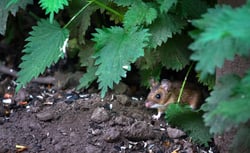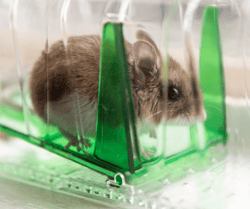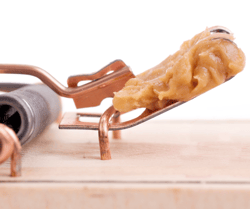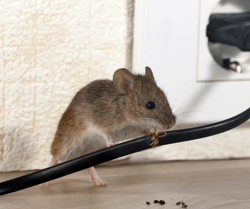When it comes to dealing with mice, many homeowners have turned to unconventional methods, and peanut butter often finds itself in the spotlight. But is it really an effective and humane way to tackle a mouse infestation, or just a myth passed down through generations? In this post, we'll delve into the science behind this popular DIY hack, discussing its merits and potential pitfalls so you can make an informed decision when facing unwanted furry visitors in your home.
Why are mice inside my home?
Mice are a common nuisance that can infiltrate homes for a multitude of reasons, with their presence often a result of a combination of environmental, behavioral, and survival factors. Understanding these dynamics helps to shed light on why and how mice find their way into residential spaces like your home.
One of the fundamental drivers behind mice entering homes is the search for shelter. These small rodents seek refuge in human dwellings, especially during harsh weather conditions. As temperatures drop in the colder months, mice are drawn to the warmth and protection offered by the walls and crevices of homes. Cracks, gaps, and unsealed entry points in a building's exterior provide easy access for these adaptable creatures.
Additionally, food and water sources play a key role in attracting mice indoors. Mice are opportunistic feeders, and the presence of crumbs, food scraps, and open food containers within homes can sustain their populations. Kitchens, pantries, and dining areas are particularly appealing to them. Even minor plumbing issues like a leaky sink or accumulated standing water can entice thirsty mice, further motivating them to enter homes.
Mice are also prolific breeders, and homes offer an ideal environment for reproduction. These rodents can multiply rapidly, with a single pair capable of producing dozens of offspring within a short period. The safety, warmth, and abundant nesting materials found in homes, such as insulation, cardboard, and fabric, create the perfect conditions for mice to establish and expand their colonies, often without homeowners even realizing it's happening.
Urbanization and habitat disruption are additional factors that drive mice into homes. As urban areas expand and natural habitats diminish, mice may lose their native living spaces. This can lead them to seek refuge in nearby human structures as they adapt to their changing surroundings. As a result, construction activities, building developments, and urban sprawl can inadvertently bring mice closer to residential areas and introduce them to our homes.
Mice's remarkable agility and flexibility enable them to infiltrate homes through tiny openings and gaps. They can squeeze through openings as small as a dime, making it challenging to seal a structure completely. Common entry points include gaps around doors, windows, utility lines, and vents. Even well-maintained homes can harbor hidden vulnerabilities that mice exploit.
Additionally, mice are often considered to be nocturnal creatures, which means they are most active during the night when human occupants are asleep or less vigilant. This survival instinct allows them to establish themselves within a home without immediate detection. They may venture out searching for food and water while residents are resting, leaving behind signs of their presence, like droppings and gnawed materials.
Lastly, mice possess an exceptional sense of smell and memory. Once they locate a food source or nesting area within a home, they can leave scent trails and remember the path, increasing the likelihood of them returning to the same location. These scent trails can also communicate to other mice that this is a safe place to live. This behavior can lead to persistent infestations, making it crucial to address the issue promptly and effectively.
In conclusion, mice invade homes for a multitude of reasons, including the search for shelter, access to food and water, favorable breeding conditions, urbanization, adaptability, and their nocturnal habits. Understanding these factors is essential for homeowners to implement effective prevention and control measures, ensuring a pest-free living environment.
 As urban areas expand and natural habitats diminish, mice may lose their native living spaces.
As urban areas expand and natural habitats diminish, mice may lose their native living spaces.
Is DIY Mice Removal Effective?
DIY mice removal methods, while appealing due to their cost-saving potential, are often ineffective in the long run and can lead to additional concerns for homeowners. Here are several key reasons why attempting to tackle a mouse infestation on your own may prove to be problematic:
- Incomplete Removal: DIY mouse removal methods typically target the visible mice through traps or poison. However, these methods often fail to address the root of the problem – the entire mouse population and their entry points. Mice are prolific breeders, and leaving even a few behind can result in a swift resurgence of the infestation. Consequently, what initially appears as a successful DIY solution can quickly transform into a recurring problem.
- Health Risks: DIY mouse removal can pose serious health risks to homeowners. Handling traps or poison without proper precautions can expose you to disease-carrying rodent droppings and urine. Moreover, if a trapped mouse dies within your walls or inaccessible areas, it can create foul odors and attract insects. Attempting to clean up after a DIY removal attempt can lead to further exposure to contaminants.
- Property Damage: DIY methods may not effectively deter mice from accessing your home. Mice are skilled at finding entry points, and without professional inspection and sealing of these openings, they can continue to infiltrate your property. As a result, you may face ongoing property damage as mice gnaw on wires, insulation, and structural materials, leading to costly repairs.
- Legal and Environmental Considerations: In many areas, using certain DIY mouse removal products or methods may be subject to regulations. Using poisons or traps improperly can have legal consequences and may harm non-target animals or pets. It's essential to be aware of local laws and regulations governing pest control.
- False Sense of Security: Successfully catching or killing a few mice with DIY methods can lead to a false sense of security. Homeowners may believe they've resolved the issue, only to discover later that the infestation persists. This can result in delayed professional intervention, further exacerbating the problem.
In summary, while DIY mouse removal may initially seem cost-effective, it often proves ineffective in the long run and can lead to additional concerns such as incomplete removal, health risks, property damage, inhumane practices, legal considerations, and a false sense of security. To effectively and safely address a mouse infestation while minimizing long-term costs and complications, it's advisable to consult with a professional pest control expert who can employ comprehensive and humane methods tailored to your specific situation.
 DIY mouse removal can pose serious health risks to homeowners.
DIY mouse removal can pose serious health risks to homeowners.
Can I Use Peanut Butter to Eliminate Mice in my Home?
Using peanut butter as bait in mouse traps is a common DIY approach for attempting to eliminate mice in the home. Since rodents are primarily nut and seed eaters, the mouse trap bait they are most strongly attracted to is peanut butter or hazelnut spread. While using peanut butter in a store-bought or a homemade mouse trap can be effective in capturing individual mice, these methods are generally ineffective for long-term mice removal. Also keep in mind that peanut butter can spoil if it's used as bait in uncontrolled climates for a long period of time which could also repel the mice.
Firstly, using peanut butter in traps primarily addresses the symptoms of a mouse infestation, not the root cause. Mice are prolific breeders, and a few trapped individuals are unlikely to represent the entire population. If the source of the infestation, such as entry points into your home or a hidden nest, is not addressed, more mice can continue to enter your home even after you've captured a few with peanut butter traps.
Secondly, DIY traps with peanut butter do not prevent mice from entering your home in the first place. To achieve long-term control, it's essential to identify and seal the entry points that mice use to gain access. Without proper prevention measures, new mice can replace those that are trapped or killed, resulting in an ongoing issue.
Additionally, relying solely on peanut butter traps can lead to health and hygiene concerns for homeowners. Handling traps with captured mice can expose you to disease-carrying rodents, their droppings, and urine. Moreover, dead mice can create unpleasant odors and attract insects, potentially leading to further problems and health risks.
In conclusion, while peanut butter can be a tempting bait for mouse traps and may provide short-term relief by capturing individual mice, it is generally ineffective for long-term mice removal. This DIY method does not address the root cause of the infestation, does not prevent new mice from entering, and can pose health and hygiene risks. To effectively and safely eliminate a mouse infestation while preventing future occurrences, it is advisable to consult with a professional pest control expert who can implement comprehensive prevention measures and use humane and effective methods tailored to your specific situation.
 DIY traps with peanut butter do not prevent mice from entering your home.
DIY traps with peanut butter do not prevent mice from entering your home.
Is DIY Mice Removal Cheaper than Professional Pest Control?
DIY mice removal methods are often perceived as cheaper than hiring a professional pest control service upfront, but this perception may not hold true in the long run. Several factors need to be considered when evaluating the cost-effectiveness of DIY vs. professional pest control:
- Effectiveness: DIY methods may not be as effective as professional pest control. If the infestation persists or worsens despite your DIY efforts, you may end up spending more money on additional traps, baits, remedies, or professional services, which can accumulate over time.
- Property Damage: Mice can cause significant damage to your property by gnawing on wires, insulation, structural materials, and contaminating food. Professional pest control services are more likely to effectively address the infestation, potentially saving you money on repair and replacement costs.
- Health Risks: DIY methods may expose you to health risks, such as handling traps with captured mice and their waste. In the event of illness or property damage due to ineffective DIY efforts, the financial and emotional costs can be substantial.
- Recurring Costs: Mice infestations often require ongoing monitoring and control efforts. DIY solutions may provide temporary relief, but if the root cause of the infestation is not addressed, you may find yourself repeatedly dealing with the problem, incurring additional costs each time.
- Time and Effort: DIY mice removal can be time-consuming and may require multiple attempts. Your time and effort have value, and the hours spent on DIY pest control could be used for other productive activities.
- Professional Guarantee: Many professional pest control services like EcoShield offer guarantees or warranties for their work. If mice return within a specified period after their treatment, they may return to address the issue at no additional cost.
In summary, while DIY mice removal may appear more cost-effective upfront, it can be less effective, potentially leading to recurring costs, property damage, health risks, and a significant investment of your time and effort. Professional pest control services provide a more cost-effective solution in the long run, as they have the expertise, resources, and tools to effectively address the infestation and prevent future occurrences. Ultimately, the decision should consider the severity of the infestation, your budget, and your willingness to invest time and energy into DIY efforts versus the convenience and effectiveness of professional pest control.
 Mice can cause significant damage to your property by gnawing on wires, insulation, structural materials, and contaminating food.
Mice can cause significant damage to your property by gnawing on wires, insulation, structural materials, and contaminating food.
Can EcoShield Help Me Prevent or Remove Mice?
Yes! At EcoShield, we believe prevention is the single best first-line of defense against rodent infestations. That’s why four-season protection is included in our Home Shield Protection Plan, providing a year-round defense against mice infestations. Have a current infestation? Not to worry! EcoShield offers guaranteed exclusion services that will rid your home of unwanted rodents now and forever with annual renewal. If you want to prevent or remove mice from your home, give EcoShield a call or fill out the form on this page today to get started.
